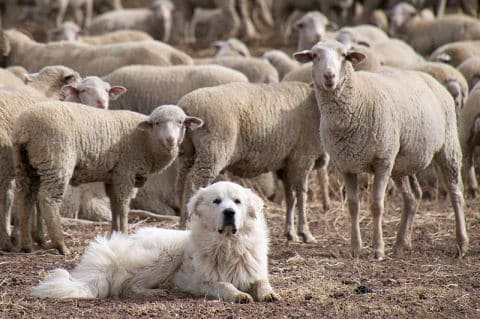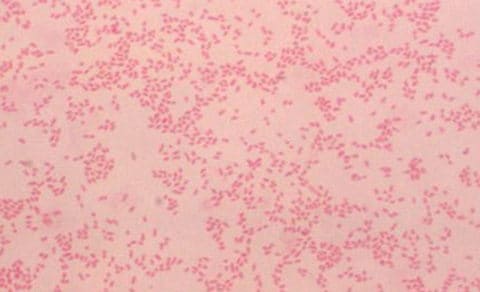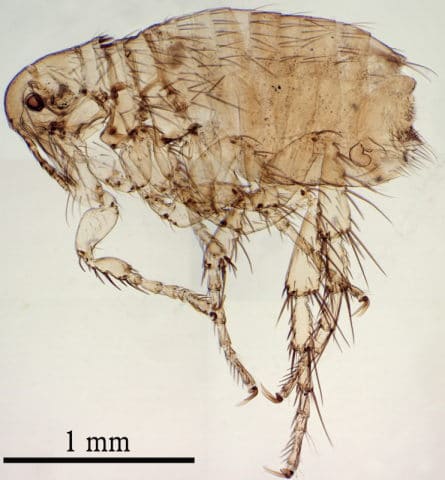For my own personal use only:
- Anthrax
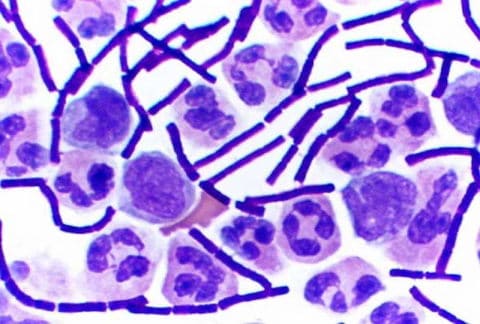
Cerebrospinal fluid with gram-positive anthrax bacteria 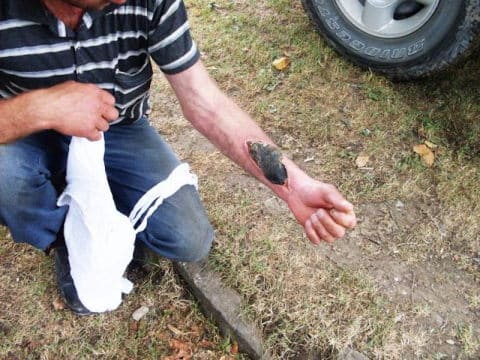
Brown-black eschar that resembles anthracite coal (hence the name anthrax, Greek for coal) on the arm of a man in the country of Georgia 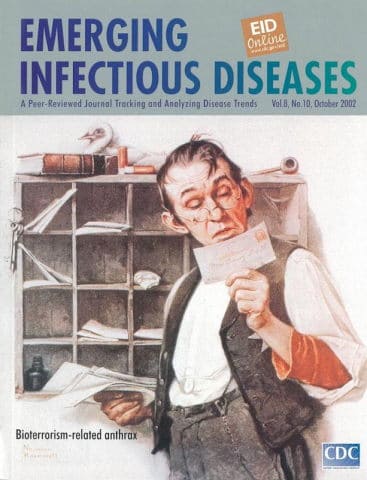
In 2001, powdered anthrax spores were mailed through the US Postal Service - Classic case:
- Cattle, sheep, goats, bison, camels, antelope:
- Sudden death
- Bloating
- Bleeding from orifices after death
- Human:
- Skin lesions with dark eschars
- Malaise
- Gastrointestinal signs
- Fever
- Acute respiratory distress
- Septicemia
- Cattle, sheep, goats, bison, camels, antelope:
- Etiology: Bacillus anthracis
- Gram-positive aerobic rod-shaped bacteria
- Bacteria sporulates when exposed to oxygen
- Endemic in North America
- Zoonotic issues:
- Routes of human infection:
- Cutaneous
- Ingestion (infected meat)
- Inhalation
- Precautions: Personal protective equipment (PPE): Respiratory protection
- Routes of human infection:
- Pearls:
- World Organisation for Animal Health (OIE) notifiable disease
- Bioterrorism agent: In 2001, powdered anthrax spores were deliberately mailed through the US Postal Service, leading to 22 infections in people & 5 deaths
- Spores persist in environment for decades
- Outbreaks can occur with heavy rainfall, flooding, or drought
- Avoid full necropsies (i.e., do not open the carcass) of affected animals as bacteria will sporulate and contaminate environment
- Classic case:
- Baylisascaris
- Classic case:
- Definitive host (raccoons, sometimes dogs or kinkajous): No clinical signs
- Intermediate host (commonly rodents, opossums, foxes, badgers, sea otters, birds, non-human primates, humans; NOT livestock):
- CNS signs
- Ocular disease
- Etiology: Baylisascaris procyonis
- Intestinal nematode
- Definitive host infected by ingesting eggs or eating infected intermediate host
- Zoonotic issues:
- Humans infected by fecal-oral transmission
- Precaution: Avoid direct contact with dog and raccoon feces
- Pearls:
- Dogs can also be intermediate hosts and develop clinical signs
- Keep dogs on monthly heartworm/nematode preventives to minimize risk of intestinal infection
- Classic case:
- Bovine tuberculosis (TB)
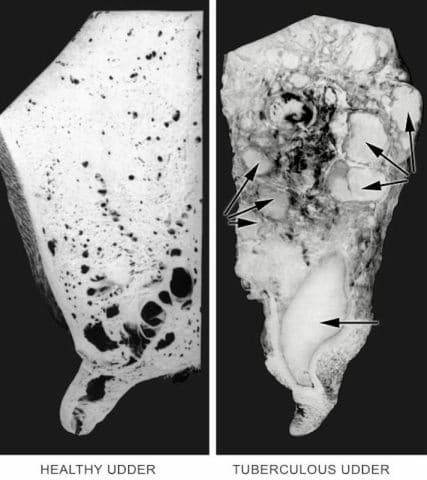
Two 1929 images comparing a healthy bovine udder (left) and an udder from a cow with tuberculosis (right) 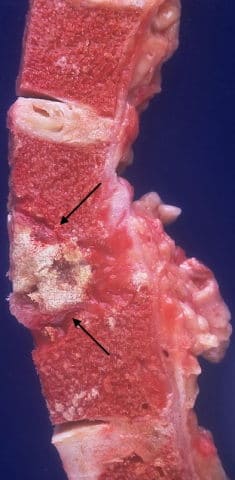
Vertebral tuberculosis (arrows) in a human - Classic case:
- Cow:
- Decreased appetite, progressive emaciation
- Cough
- Fever
- Weakness
- In humans, affects:
- Lymph nodes
- Bones
- Joints
- CNS
- Lungs
- Genitourinary system
- Cow:
- Etiology: Mycobacterium bovis
- Gram-positive, acid-fast bacterium in Mycobacterium tuberculosis complex
- Cattle are primary host
- Many "spillover" hosts (e.g., sheep, goats, horses, llamas, dogs, pigs, ferrets, cats, rodents)
- Zoonotic issues:
- Routes of human infection:
- Ingestion of unpasteurized dairy products or undercooked/raw meat
- Inhalation of aerosolized agent
- Bacterial contact on broken skin
- Wildlife and soil are potential sources of infection
- Precautions: PPE: Respiratory protection
- Routes of human infection:
- Pearls:
- OIE notifiable disease
- Canada is bovine TB-free
- Eradication programs in US and Mexico
- Control efforts in the US & routine pasteurization of milk have decreased M. bovis cases to less than 2% of total human TB cases (the rest caused by M. tuberculosis )
- Cats are rarely infected with M. bovis and have been suspected of transmitting TB to humans (and vice versa)
- Classic case:
- Brucellosis: cattle, sheep, goats, dogs
- Classic case:
- Bovine, ovine, and caprine:
- Abortions, usually in second half of gestation
- Epididymitis and orchitis in bulls
- Canine:
- Abortions, stillbirths
- Orchitis
- Diskospondylitis
- Human:
- "Undulant fever"
- Drenching sweats
- Headache
- Flu-like signs
- Can be chronic debilitating disease
- Bovine, ovine, and caprine:
- Etiologies: Brucella spp. are gram-negative, coccobacillary, facultative intracellular bacterium
- Brucella abortus : Cattle (also found in bison, elk, and [recently] feral pigs)
- B. melitensis : Ovine and caprine
- B. canis : Dogs
- Zoonotic issues:
- B. abortus and B. melitensis :
- Routes of infection:
- Ingestion of unpasteurized dairy product
- Exposure to Brucella vaccine, infected animals, or in a laboratory
- Precautions:
- PPE
- Handle vaccines with care
- Routes of infection:
- B. canis :
- Importance as a cause of disease in humans not well-established
- People infected by exposure to infected animals and in the laboratory
- Precautions: PPE
- B. abortus and B. melitensis :
- Pearls: B. abortus and B. melitensis are OIE notifiable diseases
- Bovine:
- Eradicated in Canada, nearly eradicated in US
- Possible bioterrorism agent
- Poll evil and fistulous withers in horses may be caused by B. abortus
- Ovine and caprine:
- Found in Mediterranean, Middle East, and Central America
- Exotic to Canada and US, endemic in Mexico
- Canine:
- Reportable in many US states
- Owners of Brucella-positive dogs should be advised that the disease could potentially spread to humans and dogs can’t be “cleared” of infection
- Bovine:
- Classic case:
- Bartonellosis (cat scratch fever)
- Classic case:
- Cats:
- Usually asymptomatic
- +/- Fever
- +/- Inappetence
- Humans:
- Small, reddish-brown papules or pustules at inoculation site
- Lymphadenopathy
- Fever
- Malaise
- Neurologic signs
- Psychiatric signs
- Cats:
- Etiology: Bartonella henselae
- Gram-negative rod bacterium
- Reservoir host: Domestic cats and other felids
- Transmitted via flea feces between cats
- Zoonotic issues:
- Transmitted to humans by cat bites or scratches
- Pearls:
- Worldwide distribution
- Most cases of human bartonellosis are mild or asymptomatic and self-limiting; immunocompromised people are more susceptible
- Classic case:
Images courtesy of CDC PHIL (anthrax in Georgian man, anthrax in CSF, animated B. procyonis egg, tuberculosis udder, B. canis , and journal cover), Baerni (raccoon), Yale Rosen (spinal tuberculosis), Don DeBold (dog and sheep), Luis Fernández García (flea), and John Cummings (PPE).
Top Topic Category
Cross-Species

